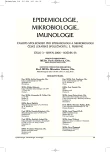Aeromonas spp. as the Causative Agent of Acute Diarrhoea in Children under 1 Year of Age
Authors:
E. Krejčí 1; A. Andělová 1; I. Porazilová 1; I. Sedláček 2
Authors‘ workplace:
Zdravotní ústav se sídlem v Ostravě, Centrum mikrobiologie, parazitologie a imunologie, Ostrava
1; Česká sbírka mikroorganismů, Masarykova Univerzita, Brno
2
Published in:
Epidemiol. Mikrobiol. Imunol. 55, 2006, č. 3, s. 92-98
Overview
Study objective:
To establish whether there is a link between cases of acute watery diarrhoea and a specific Aeromonas species.
Materials and Methods:
Eight strains studied were identified as aeromonads and were further characterized by biochemical tests, fatty acid analysis and ribotyping.
Results:
Aeromonads were isolated repeatedly from stool specimens of four children under one year of age with acute diarrhoea, two of whom were admitted to hospital. Of eight isolated aeromonads strains six were identified as A. caviae, one was classified into A. veronii bv. sobria and one could not be identified to the species level. Only two A. caviae strains from one patient were found to be identical by ribotyping while the Aeromonas species (strains) isolated from the other cases differed from one another. Contaminated fresh water, contaminated food and contact with travellers with imported diarrhoea were identified as probable sources of infection.
Conclusion:
Four cases of acute gastroenteritis in small children document that aeromonads are not rare and can cause serious health problems. However, epidemiological links remain unclear. We did not prove correlation between the four serious cases of acute diarrhoea and specific Aeromonas species but the results suggest the predominant role of A. caviae.
Key words:
Aeromonas – diarrhoea – identification – ribotyping – FAME.
Labels
Hygiene and epidemiology Medical virology Clinical microbiologyArticle was published in
Epidemiology, Microbiology, Immunology

2006 Issue 3
Most read in this issue
- Aeromonas spp. as the Causative Agent of Acute Diarrhoea in Children under 1 Year of Age
- Head Louse: Taxonomy, Incidence, Resistance, Delousing
- Seroprevalence of Antibodies Against Hepatitis A Virus and Hepatitis B Virus in Nonvaccinated Adult Population over 40 Years of Age
- Molecular Detection and Subtyping of Treponema pallidum subsp. pallidum in Clinical Specimens
